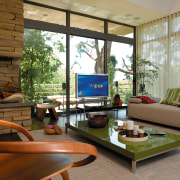At your service
If programming your VCR made you a slave to technology, understanding today's audiovisual and automation equipment puts you back in control

As the demands on our time become greater, our leisure time is more valuable than ever before. The way we are designing our homes reflects this, as increasingly we are turning to technology to provide a solution to how we spend that leisure time.
One of the smartest trends to hit the home building industry is a multi-room system. But, what are the benefits of wiring for multi-room distribution? In this installment, we ask the experts how we can best make use of our home entertainment dollar, and what we should be doing to ensure the best possible experience now and in the future.
How should the home theatre or home audio budget be distributed?
In the days of analogue audio equipment the process was fairly simple, and believe it or not, not much has changed, says Michael Williams of W C Wedderspoon.
"There's an old hi-fi rule that you spend half on speakers and half on electronics. While keeping an eye on that 50/50 split, it's a good idea to experiment.Try different speakers with different components and vice versa."
A similar approach to home theatre is also advised, says Stephen Tyro of Tyro Audio Visual Design and Integration.
"The general rule of thumb is a third on the speakers, a third on the display device (projector and screen or television) and a third on electronics."
So now that we know how to spend our money, the question now is, how do we know which technology is going to offer us the best value?
How has audiovisual technology progressed in recent years and where do you see it heading?
There's no doubting that technology has come on in leaps and bounds, but that doesn't necessarily mean it has always been for the better, says Williams.
"Progressed is not really a term we use. Compressed formats MP3 and 3D audio for example don't give you true audio quality. The result is that we are being trained to listen to lesser quality audio, without all the nuances that musicians put into their music. The upside of this technology is it has brought kids back to listening to music when they're out and about.
"As for what is to come, convergence is the buzz-word for future technology, as audio and computers become more interchangeable."
It's a view shared by Paul Kao of Playtech.
"In the next five years at least, we will see a further blurring of the boundary between PC and AV equipment. They will share the same fundamental functionalitywith some unique features specifically designed for the people using them."
The convergence trend is something that Tyro also sees as inevitable.
"There has been an increased move towards the integration of equipment and wireless technology. There will be a greater emphasis on smart technology where you will see a number of manufacturers banding together and offering componentry that can talk to each other."

Okay, so our audiovisual equipment will become smarter. It only remains to be seen if we humans will be able to keep up.
Future proofing is the current technological catch phrase. Short of building a smart house, how can existing homeowners take advantage of this?
Kao believes the best choice is to prepare for tomorrow with the tools readily available today.
"One important thing for existing homeowners, is to look at installing a network system in their home. Wired or wireless, make sure it is robust and easily accessed within each room. You will see many products in the future that will fully utilise networking with each other, so without a good network, you won't get to enjoy the benefits associated with these new technologies."
Hamish Andrews of Pudney and Lee also believes that a robust network should be the mainstay of any future-proofed home.
"As technology constantly changes, consumers either need to upgrade or replace goods. Therefore, so-called future proofing your home depends on the life-cycle and connectivity of the product. However, with good planning, homeowners can certainly overcome certain pitfalls and take advantage to maximise the options available.
"When renovating a home, or planning a new home project, homeowners should plan on pre-wiring as much as they can, in as many rooms as they can. Every bedroom should contain television jacks, phone and data connections. The lounge and living rooms should be wired for home entertainment audio and video cables, while speaker cables should extend to outside entertainment areas."
Andrews says one very simple and effective way to help data and home entertainment cabling is to install a conduit system. This is a hollow pipe allowing data, audio or video cables to feed through it. If at any point in the future you decide to add or remove cables, you can do so without the hassle, time, and costly expense of having to remove wall lining materials, such as such as plasterboard.
Story by: Trendsideas
Home kitchen bathroom commercial design








